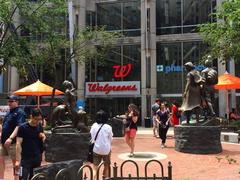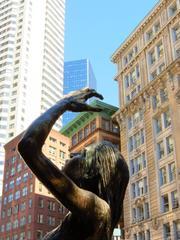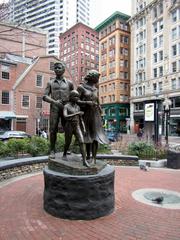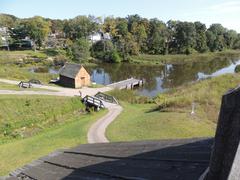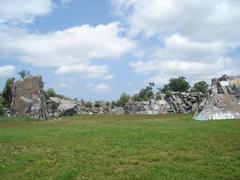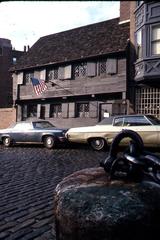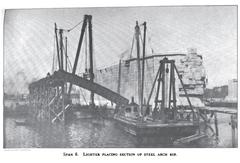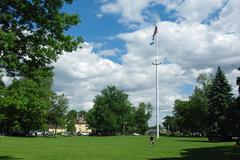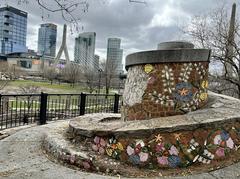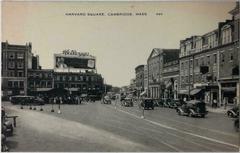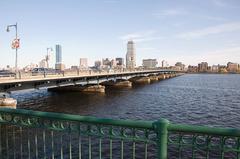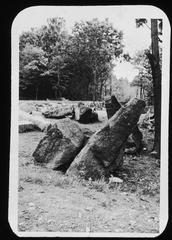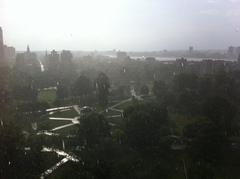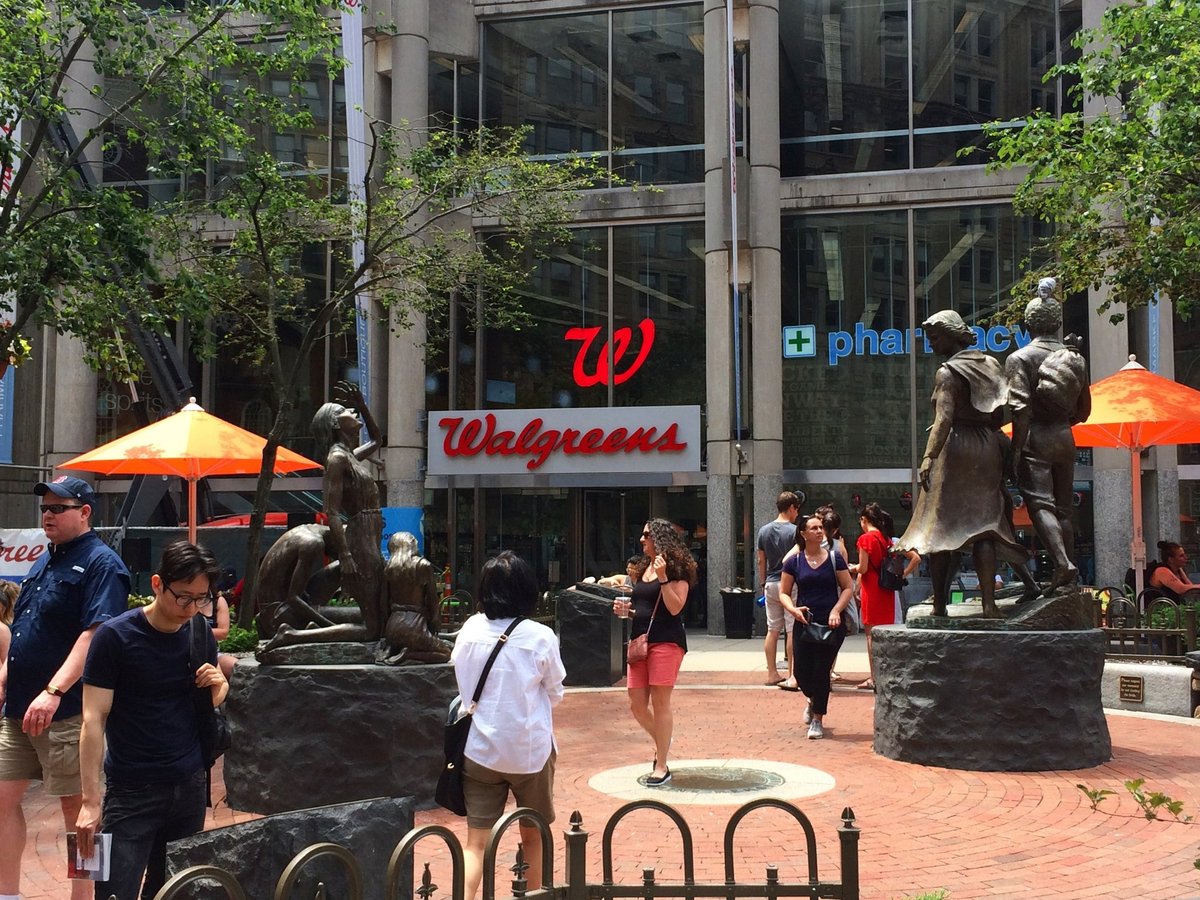
Irish Famine Memorial Boston Visitor Guide
Publication Date: 31/07/2024
Introduction to the Irish Famine Memorial
The Boston Irish Famine Memorial stands as a poignant tribute to one of the most tragic episodes in Irish history, the Great Famine of 1845–1852. Located at the corner of Washington and School Streets in Boston’s Downtown Crossing district, this memorial not only commemorates the victims and survivors of the Great Irish Famine but also celebrates the resilience and contributions of the Irish community in America. Unveiled on June 28, 1998, the memorial was spearheaded by Boston Mayor Raymond Flynn and Irish-American real estate tycoon Thomas J. Flatley (Wikipedia). The sculptures designed by Robert Shure present a stark contrast between an emaciated family suffering during the famine and a prosperous family that immigrated to America, symbolizing both the despair and hope of the Irish immigrant experience (IrishCentral). Encircling the statues are narrative plaques that detail the historical context of the famine and its enduring impact, making the memorial a significant educational and cultural landmark. Visitors can explore the memorial year-round, free of charge, and gain insights into a pivotal period in both Irish and American history.
Contents Overview
- Visiting the Boston Irish Famine Memorial: History, Tickets, and Tips
- History of the Irish Famine Memorial
- Origins and Development
- Design and Features
- Unveiling and Public Reception
- Historical Context
- Visitor Information: Tickets, Hours, and Accessibility
- Tickets and Visiting Hours
- Accessibility
- Nearby Attractions
- Special Events and Guided Tours
- Photographic Spots
- FAQ
- Boston Irish Famine Memorial: History, Visiting Hours, and Cultural Significance
- Introduction
- Significance of the Memorial
- Historical Context
- Memorial’s Inception and Unveiling
- Artistic Representation
- Narrative Plaques
- Visitor Information
- Location and Accessibility
- Ticket Prices and Opening Hours
- Guided Tours and Photographic Spots
- Special Events
- Cultural and Educational Impact
- Criticisms and Support
- Commemorative Events
- Legacy and Future Plans
- Visitor Tips
- FAQ
- Visitor’s Guide to the Boston Irish Famine Memorial: History, Significance, and Tips
- Introduction
- Description of the Memorial
- Artistic Representation
- Narrative Plaques
- Integration with Boston’s Heritage Trails
- Visitor Experience
- Special Events and Commemorations
- Educational Opportunities
- Visitor Information
- FAQ
- Conclusion
Visiting the Boston Irish Famine Memorial: History, Tickets, and Tips
History of the Irish Famine Memorial
Origins and Development
The idea for the Irish Famine Memorial in Boston was first announced by Mayor Raymond Flynn in May 1993. Flynn emphasized that the memorial was not just about Ireland but also about human dignity and respect (Wikipedia). Initially, the proposed location was at Faneuil Hall Marketplace. However, the project faced delays when Flynn left City Hall to become the U.S. ambassador to the Vatican later that year.
The project was revitalized in 1996 when Thomas J. Flatley, an Irish-American real estate tycoon, took the lead. Flatley convened a committee meeting on May 1, 1996, which included Irish-American officials, business leaders, historians, and university presidents (Wikipedia). The Boston Arts Commission helped solicit design bids, and in April 1997, sculptor Robert Shure was selected to create the memorial.
Design and Features
The Boston Irish Famine Memorial was designed by Robert Shure and features two groups of statues. One group depicts a starving and emaciated Irish family suffering during the Great Famine of 1845-1852, while the other group shows a prosperous family that had immigrated to America (IrishCentral). The sculptures are accompanied by eight narrative plaques that provide historical context for the Irish famine and connect it to modern famines in Africa and other places.
The memorial is located on a plaza between Washington Street and School Street, near Downtown Crossing. It is part of Boston’s Irish Heritage Trail, which includes 40 landmarks in downtown Boston and the city’s neighborhoods (Atlas Obscura).
Unveiling and Public Reception
The Boston Irish Famine Memorial was unveiled on June 28, 1998, to mark the 150th anniversary of the Great Famine. The ceremony was attended by 7,000 people, including notable figures from the Irish-American community (Wikipedia). The memorial received immediate praise from visitors for its poignant depiction of the Irish immigrant experience.
However, the memorial has also faced criticism and has been described as “the most mocked and reviled public sculpture in Boston” (Wikipedia). Critics argue that the sculptures are overly sentimental and lack artistic sophistication. Despite the mixed reviews, the memorial remains a significant landmark and a powerful reminder of the struggles faced by Irish immigrants.
Historical Context
The Great Famine, also known as the Irish Potato Famine, occurred between 1845 and 1852 and led to the death of approximately one million people and the emigration of another million. The famine was caused by a potato blight that destroyed the primary food source for the majority of the Irish population (Mass Moments). The British government’s inadequate response to the crisis exacerbated the suffering, leading to widespread malnutrition, disease, and death.
Boston played a significant role in responding to the famine. In 1847, the Boston Relief Committee, headed by Mayor Josiah Quincy Jr., collected 800 tons of food and clothing and persuaded the U.S. government to allow a fully-loaded warship to sail on a mercy mission from Boston to Ireland (Mass Moments). By 1855, there were more than 50,000 Irish in Boston, and over the next decades, they transformed the city’s political, social, and cultural life.
Visitor Information: Tickets, Hours, and Accessibility
Tickets and Visiting Hours
The Boston Irish Famine Memorial is free to visit and is accessible 24 hours a day, year-round. There are no tickets required for entry, making it an easily accessible landmark for both tourists and locals.
Accessibility
The memorial is wheelchair accessible and is located on a flat plaza, making it easy to navigate for people with disabilities. There are also benches nearby for those who may need to rest.
Nearby Attractions
The memorial is situated adjacent to the Freedom Trail, a 2.5-mile-long trail that passes through 16 historically significant sites in Boston (Snoflo). Other nearby attractions include Faneuil Hall, the Old State House, and Boston Common, all within walking distance.
Special Events and Guided Tours
The memorial occasionally hosts special events, particularly around significant anniversaries related to the Great Famine or Irish-American history. Guided tours are available through various Boston historical tour companies, which provide in-depth insights into the memorial and its context within the broader history of Boston and the Irish diaspora.
Photographic Spots
The memorial offers several excellent photographic opportunities. The contrast between the statues of the suffering family and the prosperous family provides a poignant visual narrative. Early morning or late afternoon light can add dramatic shadows and highlights to the sculptures, making for striking photos.
FAQ
When is the best time to visit the Boston Irish Famine Memorial?
The best time to visit the Irish Famine Memorial is during the spring or fall when the weather is mild, and the foliage is at its peak. However, the site is open year-round and can be visited at any time (Snoflo).
Is the Boston Irish Famine Memorial accessible for people with disabilities?
Yes, the memorial is wheelchair accessible and situated on a flat plaza, making it easy to navigate for people with disabilities.
Call to Action
In conclusion, the Boston Irish Famine Memorial stands as a testament to the resilience and contributions of Irish immigrants. Despite facing criticism, it remains a significant historical landmark that continues to educate and inspire visitors from around the world. Download the Audiala mobile app for an interactive guide to Boston’s historical sites, and follow us on social media for more updates and travel tips!
Boston Irish Famine Memorial: History, Visiting Hours, and Cultural Significance
Introduction
The Boston Irish Famine Memorial stands as a poignant reminder of one of the most tragic episodes in Irish history, the Great Famine of 1845–1852. This article delves into the historical significance of the memorial, provides vital visitor information, and highlights its cultural and educational impact.
Significance of the Memorial
Historical Context
The Boston Irish Famine Memorial is a solemn tribute to the Great Famine of 1845–1852, also known as An Gorta Mor (The Great Hunger), which saw the failure of the potato crop due to potato blight, leading to mass starvation and disease. Between 1845 and 1849, approximately 100,000 men, women, and children fled Ireland for Boston to escape these dire conditions (TripSavvy).
Memorial’s Inception and Unveiling
Unveiled on June 28, 1998, as part of the worldwide 150th anniversary of the Great Hunger, the memorial was conceived through the efforts of Boston Mayor Raymond Flynn and championed by Irish-American real estate tycoon Thomas J. Flatley. The project was led by a group of Irish-American cultural leaders, university presidents, historians, business leaders, and art administrators (Irish Echo).
Artistic Representation
The memorial features twin statues by sculptor Robert Shure. One statue depicts an Irish family dying of starvation in Ireland, while the other shows a second Irish family making their way in America with optimism and resolve, yet looking back sadly at the family left behind. This juxtaposition captures the heartache and hope of Ireland’s Famine generation (Irish Echo).
Narrative Plaques
Eight narrative plaques encircle the statues, telling the story of the Famine years. These plaques detail the dire living conditions in 19th-century Ireland, exacerbated by absentee landlordism and colonialism, and the successive crop failures. They also highlight the heroic efforts made by Bostonians to alleviate the suffering, such as the voyage of the USS Jamestown. The final plaque, ‘Lest We Forget,’ serves as a reminder that famines continue to decimate populations around the world today (Irish Echo).
Visitor Information
Location and Accessibility
Located at the corner of Washington and School Streets in downtown Boston, the memorial is situated across from the Old South Meeting House. It is part of Boston’s famous Freedom Trail and the Irish Heritage Trail, making it easily accessible to millions of residents and visitors from around the world (Irish Echo).
Ticket Prices and Opening Hours
The Boston Irish Famine Memorial is open to the public 24/7 and is free of charge. There are no ticket prices, making it an accessible historical site for all visitors.
Guided Tours and Photographic Spots
Guided tours are available through various Boston historical tours, which often include the memorial as part of a broader exploration of Boston’s rich history. Popular photographic spots include the twin statues and the narrative plaques, which offer both artistic and educational insights.
Special Events
Throughout the year, the memorial hosts various commemorative events, such as the annual remembrance on June 28th, featuring reflections from local leaders, traditional Irish music, and blessings of the memorial park. Check the official websites for updates on upcoming events.
Cultural and Educational Impact
Criticisms and Support
Despite its noble intentions, the memorial has not been immune to criticism. Some detractors argue that it overly glorifies the achievements of Irish-Americans while downplaying the magnitude of the famine itself. However, supporters counter that it serves as a testament to the resilience and contributions of Irish immigrants to American society, while still acknowledging the profound suffering endured by their ancestors (GoXplr).
Commemorative Events
The 25th anniversary of the Boston Famine Memorial was commemorated on June 28, 2023. The event featured reflections from local leaders, traditional Irish music, and a blessing of the memorial park. Among the confirmed speakers were Irish Vice Consul General Paul Rooney, sculptor Robert Shure, former U.S. Ambassador Ray Flynn, and Boston City Council President Ed Flynn (Irish Echo).
Legacy and Future Plans
Legacy and Future Plans
As part of his legacy, Thomas J. Flatley and his family established the Irish Famine Memorial Fund at Boston College. The fund’s mission is to provide financial or material support to BC alumni and others working to alleviate poverty, disease, famine, and illiteracy across the globe (Irish Echo).
Additionally, the Irish Great Hunger Memorial Committee is working on a new vision for the memorial on Deer Island. This project includes a 16-foot classic Irish/Celtic cross carved in granite, which will sit on a four-foot concrete foundation overlooking Boston Harbor. Informative plaques and granite blocks will surround the cross, explaining the significance of the memorial (Boston Irish).
Visitor Tips
Nearby Attractions
For those planning to visit the Boston Irish Famine Memorial, it is recommended to explore the surrounding area as well. The memorial is located near several other historical sites, including the Old South Meeting House and the Granary Burying Ground. Visitors can also follow the Irish Heritage Trail, which connects 20 downtown Boston sites related to Irish-American history (TripSavvy).
Travel Tips
For a more immersive experience, consider visiting nearby Irish pubs such as jm Curley at 21 Temple Place or The Kinsale Irish Pub & Restaurant at 2 Center Plaza. These establishments offer a taste of Irish culture and hospitality, enhancing the overall visit to the memorial (TripSavvy).
FAQ
Q: What are the visiting hours for the Boston Irish Famine Memorial?
A: The memorial is open 24/7 and is free to the public.
Q: Are there guided tours available?
A: Yes, guided tours are available through various Boston historical tours.
Q: Where is the Boston Irish Famine Memorial located?
A: It is located at the corner of Washington and School Streets in downtown Boston.
Q: Are there any special events at the memorial?
A: Yes, the memorial hosts various commemorative events throughout the year. Check official websites for updates.
Conclusion
The Boston Irish Famine Memorial is a poignant and educational landmark that honors the resilience and contributions of Irish immigrants while acknowledging the profound suffering of their ancestors. Its location, artistic representation, and narrative plaques make it a significant site for both historical education and cultural appreciation. To stay updated on events and more, follow the memorial on social media or visit its official website.
Visuals and Media
Boston Irish Famine Memorial Statues at the Memorial Narrative Plaques
Internal and External Links
- Freedom Trail
- Irish Heritage Trail
- Old South Meeting House
- Granary Burying Ground
Summary and Final Thoughts
The Boston Irish Famine Memorial serves as a powerful testament to the resilience and contributions of the Irish community in America while also honoring the memory of the millions who suffered and perished during the Great Irish Famine. Despite facing criticism for its artistic choices, the memorial remains a significant historical and cultural landmark. It educates visitors on the dire conditions of 19th-century Ireland and the subsequent journey of Irish immigrants to America, highlighting both their struggles and achievements (Irish Echo). The memorial’s location in downtown Boston makes it easily accessible and a must-visit for anyone interested in Irish-American history. As part of the broader Irish Heritage Trail and the Freedom Trail, it offers a comprehensive and moving account of this tragic period. The ongoing efforts to maintain and enhance the memorial, including future plans for additional commemorative projects, ensure that the legacy of the Great Famine and the contributions of the Irish diaspora will continue to be remembered and celebrated (Boston Irish). For more information and to stay updated on events, visitors are encouraged to download the Audiala mobile app and follow the memorial on social media.
Sources and Further Reading
- Wikipedia (2024). Boston Irish Famine Memorial. Retrieved from Wikipedia
- IrishCentral (2024). Irish Famine Immigrants in Boston. Retrieved from IrishCentral
- Irish Echo (2023). Boston Commemorates Famine Memorial 25th Anniversary. Retrieved from Irish Echo
- Boston Irish (2024). Revival Dream at Deer Island. Retrieved from Boston Irish
